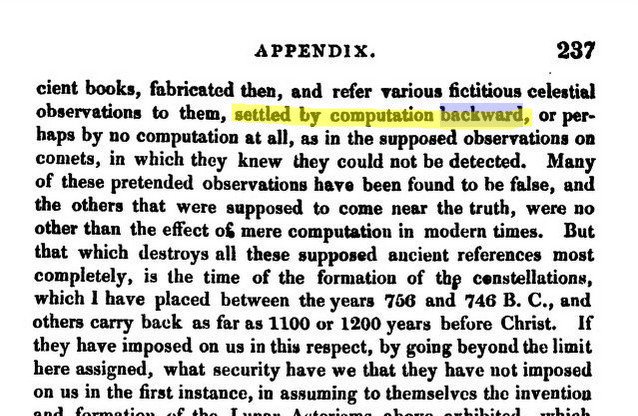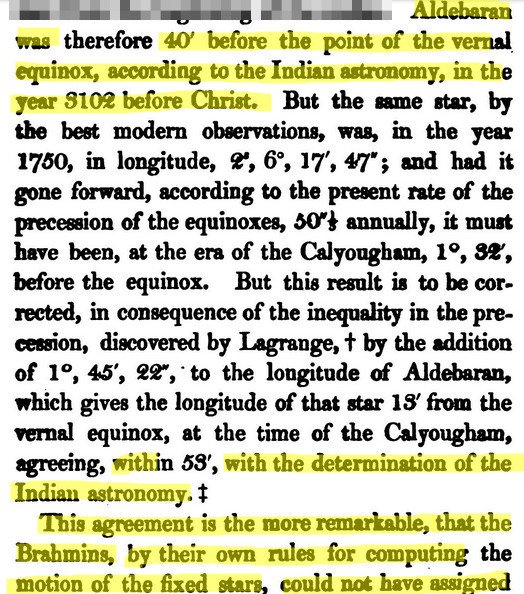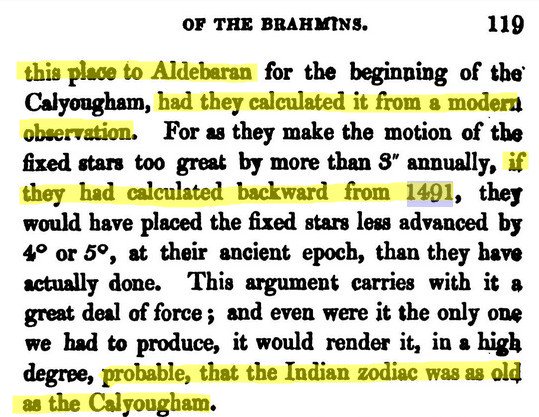But any such thing mentioned in Hindu Scriptures is back calculation by crafty Brahmins per Indologists. https://twitter.com/RT_com/status/924979200322424833">https://twitter.com/RT_com/st...
In 1790, the Scottish mathematician John Playfair demonstrated that the starting-date of the astronomical observations recorded in the +
tables still in use among Hindu astrologers (of which three copies had reached Europe between 1687 and 1787) had to be 4300 BC.
^^ Source: “Remarks on the astronomy of the Brahmins”, Edinburg 1790, pp 91, link below.
https://archive.org/details/worksjohnplayfa00playgoog">https://archive.org/details/w...
https://archive.org/details/worksjohnplayfa00playgoog">https://archive.org/details/w...
In1825, Bentley objected to Playfair with a Biblical argument as follows:
pp 30/346
#page/n29/mode/2up/search/fable">https://archive.org/stream/in.ernet.dli.2015.109519/2015.109519.A-Historical-View-Of-The-Hindu-Astronomy--Part-1-2 #page/n29/mode/2up/search/fable">https://archive.org/stream/in...
pp 30/346
#page/n29/mode/2up/search/fable">https://archive.org/stream/in.ernet.dli.2015.109519/2015.109519.A-Historical-View-Of-The-Hindu-Astronomy--Part-1-2 #page/n29/mode/2up/search/fable">https://archive.org/stream/in...
And Bentley, in true protestant Padre masquerading as scholar fashion, accused Brahmins of back calculation.
#page/n283/mode/2up/search/backward">https://archive.org/stream/in.ernet.dli.2015.109519/2015.109519.A-Historical-View-Of-The-Hindu-Astronomy--Part-1-2 #page/n283/mode/2up/search/backward">https://archive.org/stream/in...
#page/n283/mode/2up/search/backward">https://archive.org/stream/in.ernet.dli.2015.109519/2015.109519.A-Historical-View-Of-The-Hindu-Astronomy--Part-1-2 #page/n283/mode/2up/search/backward">https://archive.org/stream/in...
But John Playfair refuted this backward computation argument in his 1790 book itself.
#page/n128/mode/2up/search/1491">https://archive.org/stream/worksjohnplayfa00playgoog #page/n128/mode/2up/search/1491">https://archive.org/stream/wo...
#page/n128/mode/2up/search/1491">https://archive.org/stream/worksjohnplayfa00playgoog #page/n128/mode/2up/search/1491">https://archive.org/stream/wo...
So, it turns out that the data given by the Brahmins corresponded not with the results deduced from their formulae, but with the actual+
positions, and this, according to Playfair, for nine different astronomical parameters.
That Hindu astronomical lore about ancient times cannot be based on later back-calculation was also argued by French astronomer jean-Bailly.
It is something of a scandal that Playfair’s and Bailly’s findings have been lying around for two hundred years while linguists+
and indologists were publishing speculations on Vedic chronology in stark disregard for the contribution of astronomy.
Another important astronomical event mention in Hindu Scriptures is the start of Kaliyuga.
Hindu tradition makes mention of the conjunction of the “seven planets” near the fixed star Revati on 18 February 3102 BC.
This date, at which Krishna is supposed to have left earth for his Goloka, is conventionally the start of the so-called Kali-Yuga.
However, Indologists claim that the Kali-Yuga system of time-reckoning was a much younger invention, not attested before the 6th century AD.
Against this Indologist opinion, Bailly and Playfair had already shown that the position of the moon (the fastest-moving “planet”, +
hence the hardest to back-calculate with precision) at the beginning of Kali-Yuga, 18 February 3102, as given by Hindu tradition, +
was accurate to 37’. Either Brahmins had made an incredibly lucky guess,or they had recorded an actual observation on Kali Yuga day itself.
R L. Thompson argues that Brahmins are correct in mentioning this remarkable conjunction on that exact day.
https://www.amazon.com/Vedic-Cosmography-Astronomy-Richard-Thompson/dp/0892132698">https://www.amazon.com/Vedic-Cos...
https://www.amazon.com/Vedic-Cosmography-Astronomy-Richard-Thompson/dp/0892132698">https://www.amazon.com/Vedic-Cos...
Though it was not spectacularly exact, having an orb of 370 between the two most extreme planetary positions.
But that precisely supports the hypothesis of an actual observation as opposed to a back-calculation.
Indeed, if Hindu astronomers were able to calculate this position after a lapse of many centuries (when the Jyotisha-ShAstra was written),+
it is unclear what reason they would have had for picking out that particular conjunction.
If the Hindu astronomers had simply been going over their astronomical tables looking for an exceptional conjunction, +
they could have found more spectacular ones than the one on 18 February 3102 BC.
And why would they have calculated tables for such a remote period, sixteen centuries before the Aryan invasion, +
nineteen before the composition of the Rg-Vedic hymns, a time of which they had no recollection?
Abv tweets were from the following chapter of the book " UPDATE ON THE ARYAN INVASION DEBATE" by @Koenraad_Elst
http://voiceofdharma.org/books/ait/ch22.htm">https://voiceofdharma.org/books/ait...
http://voiceofdharma.org/books/ait/ch22.htm">https://voiceofdharma.org/books/ait...

 Read on Twitter
Read on Twitter






